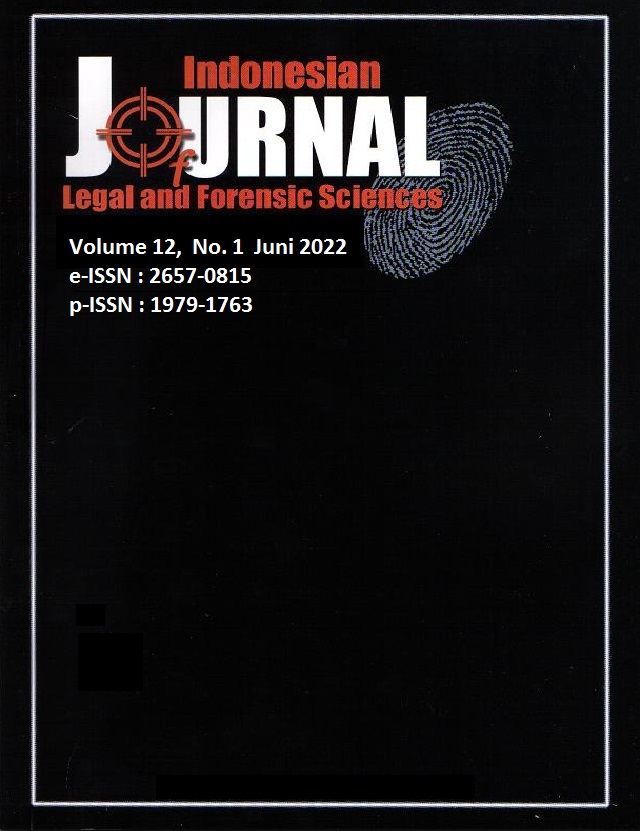Intercanine Distance (ICD) Measurement Using Metric Analysis And Digital Imaging in Bite Mark Gender Identification
Abstract
This study aims to determine a gender using Intercanine Distance (ICD) measurement on bite marks with digital imaging and metric analysis. This is a Narrative Literature Review on 11 articles that meet the research requirements, and articles obtained from PubMed, Science Direct, and Wiley databases. It was found that the ICD of men and women measured with metric analysis and digital imaging was significantly different. Therefore, it was suggested that metric analysis is an excellent method to identify gender on bite marks compared to digital imaging, this method is practical, low budget, quick, and accurate.
Downloads
References
[2] Ebrahim, Eshitha, Prasanna Kumar Rao, Laxmikanth Chatra, Prashanth Shenai, Veena Km, Rachana V Prabhu, Shahin Ka, et al. 2014. “Dental age estimation using Schour and Massler method in south indian children.” Scholars Journal of Applied Medical Sciences 2 (5C): 1669–74. www.saspublisher.com.
[3] Malinda, Yuti, dan Dewi Zakiawati. 2015. “Acquaintance of bite mark identification procedures in Forensic Odontology.” Padjadjaran Journal of Dentistry. https://doi.org/10.24198/pjd.vol27no3.13557.
[4] Jha, Prakash Chandra, N C Sanghamesh, Abhijeet Alok, Shivani Singh, Braj Bushan Bharti, dan Rakesh Raj. 2015. “Dimorphism of Canine : A Diagnostic Value in Gender Identification - A Clinical Study.” International Journal of Scientific Study 3 (8): 81–84. https://doi.org/10.17354/ijss/2015/513.
[5] Kashyap, Bina, Sanjeev Anand, Sudhakara Reddy, ShruthiBasavaradhya Sahukar, Naga Supriya, dan Swetha Pasupuleti. 2015. “Comparison of the bite mark pattern and intercanine distance between humans and dogs.” Journal of Forensic Dental Sciences 7 (3): 175. https://doi.org/10.4103/0975-1475.172419.
[6] Pangestu, Mentari, Bambang Hidayat, dan Fahmi Oscandar. 2016. “Identifikasi Pola Rugae Palatina untuk Klasifikasi Jenis Kelamin Manusia Dengan Citra Digital Menggunakan Metode Gabor Wavelet dan Fuzzy K-Nn.” In e-Proceeding of Engineering, 3:1846–53.
[7] Okoli, Chitu, dan Kira Schabram. 2010. “A Guide to Conducting a Systematic Literature Review of Information Systems Research.” Sprouts 10 (2010). https://doi.org/10.2139/ssrn.1954824.
[8] Fidya, Fidya, dan Astika Swastirani. 2019. “Differences of inter-canine distance on dental cast model, wax impression tracing, radiograph of dental impression tracing, and dental cast tracing methods of human bite mark.” Padjadjaran Journal of Dentistry 31 (1): 47. https://doi.org/10.24198/pjd.vol31no1.16614.
[9] Rajarathnam, BasettyNeelakantam, MariaPriscilla David, dan AnnamalaiPonnuswamy Indira. 2016. “Mandibular canine dimensions as an aid in gender estimation.” Journal of Forensic Dental Sciences 8 (2): 83. https://doi.org/10.4103/0975-1475.186364.
[10] Singh, Rohini, Kriti Garg, dan Shiv Kumar Singh. 2017. “Sex Determination by Evaluating Inter-Canine Distance and MesioDistal Width of Mandibular Canine.” International Healthcare Research Journal 1 (9): 284–91. https://doi.org/10.26440/ihrj/01_09/132.
[11] B, Cakici, Aka PS, Sevim Erol A, dan Arıcı G. 2017. “Comparison of Bimaxillary Permanent Canine Arch Width in Terms of Human Sex Identification for Metric Analysis of Bite Marks.” Journal of Anthropology Reports 02 (01): 2–4. https://doi.org/10.35248/2684-1304.17.2.116.
[12] Ibeachu, P.C., B.C. Didia, dan C.N. Orish. 2012. “Sexual dimorphism in mandibular canine width and intercanine distance of University of Port-Harcourt student, Nigeria.” Asian J Med Sci 2 (February 2019): 166–69. https://www.researchgate.net/publication/307534588%0A.
[13] Sandeep, Kaur, Kaur Kirandeep, dan Abhiroop Singh. 2016. “Bite Mark Analysis in Forensic Odontology.” International Journal of Dental and Health Sciences 3 (3): 650–64.
[14] Tarazona, B., J. M. Llamas, R. Cibrian, J. L. Gandia, dan V. Paredes. 2013. “A comparison between dental measurements taken from CBCT models and those taken from a Digital Method.” European Journal of Orthodontics 35 (1): 1–6. https://doi.org/10.1093/ejo/cjr005.
[15] Augustin, Irvie, Dr.Ir. Bambang Hidayat, DEA, dan Drg. H. Fahmi Oscandar. 2018. “Identifikasi Jenis Kelamin Berdasarkan Teraan Gigitan Berbasis Pengolahan Citra Digital Dengan Metode Discrete Wavalet Transform ( Dwt ) Dan Klasifikasi K-Nearest Neighbor ( Knn ).” In e-Proceeding of Engineering, 5:4820–27.
[16] Leksono, Yonita Ersalina, Rita Purnamasari, dan Yuti Malinda. 2019. “Identifikasi Jenis Kelamin Berdasarkan Teraan Gigitan Berbasis Pemugaran Citra Dengan Metode Gray Level Co-Occurence Matrix ( Glcm ) Dan Klasifikasi Support Vector Machine ( Svm ).” In e-Proceeding of Engineering, 6:3942–50.
[17] Ali, Ibrahim K., Kaustubh Sansare, dan Freny R. Karjodkar. 2018. “Analysis of Intercanine Distance and Dimensional Changes in Bite Marks on Foodstuffs Using Cone Beam Computed Tomography.” American Journal of Forensic Medicine and Pathology 39 (3): 213–17. https://doi.org/10.1097/PAF.0000000000000399.
[18] Taufik, Adrian Firmansyah, Bambang Hidayat, dan Fahmi Oscandar. 2016. “Identification of Rugae Palatine Using Digital Image Processing Technique with Spatial Processing and Fuzzy Logic Classification.” In e-Proceeding of Engineering, 3:1710–16.
[19] Rachmawati, Fauziyyah, Bambang Hidayat, dan Fahmi Oscandar. 2018. “Identifikasi Usia Berdasarkan Pengolahan Citra Panoramik Molar Pertama Mandibula Dengan Metode Discrete Cosine Transform (Dct) Dan Klasifikasi K-Nearest Neighbor (K-Nn).” In e-Proceeding of Engineering, 5:4916–22.



















